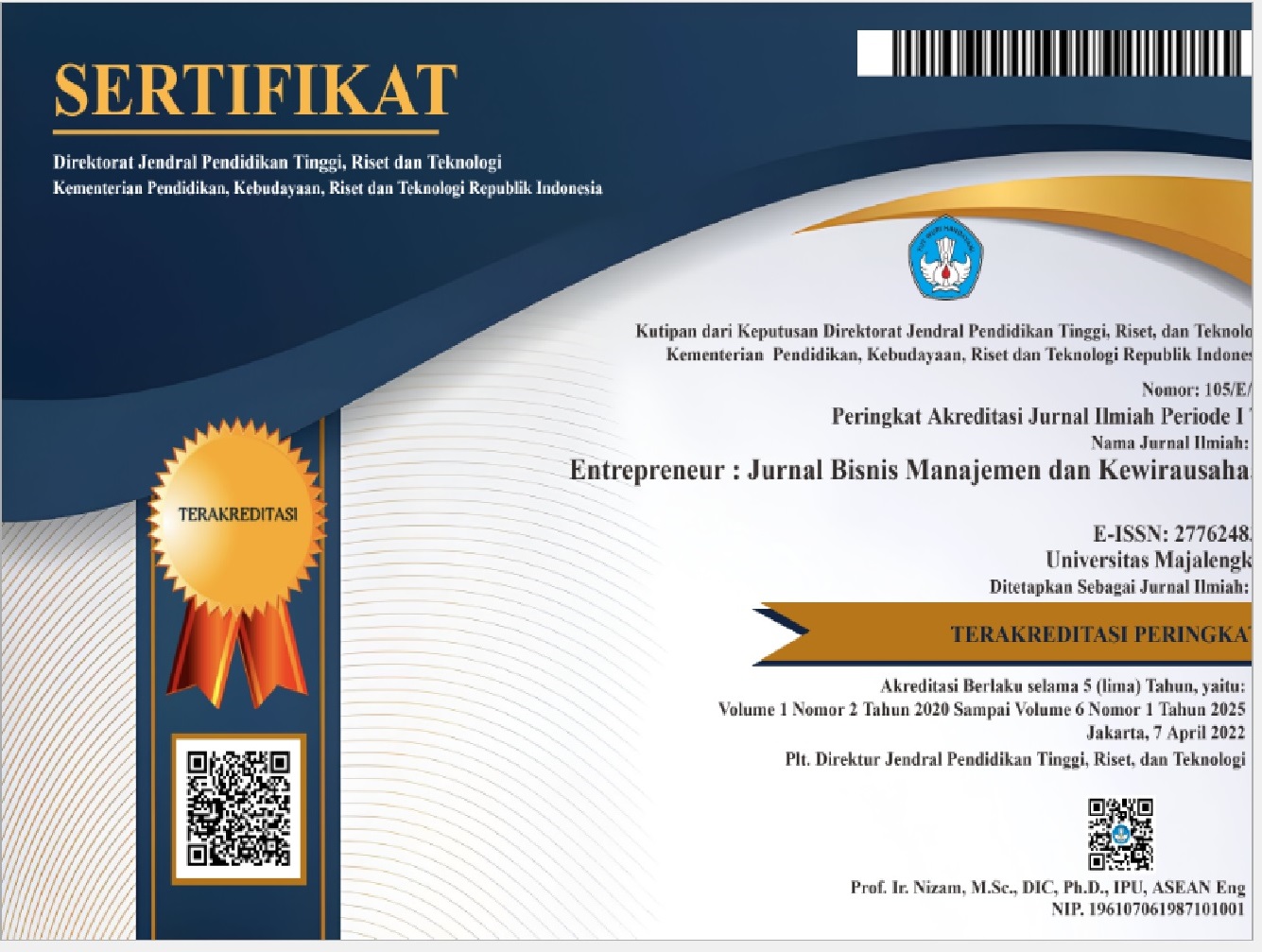Pengaruh Motivasi Dan Kompetensi Terhadap Kinerja Perawat Di Instalasi Paviliun Tandang Pada Rumah Sakit Umum Daerah Kabupaten Sumedang
DOI:
https://doi.org/10.31949/entrepreneur.v3i1.1167Abstract
The findings of this study prove all the hypotheses of this research, namely that there is an influence of work motivation and competence, either simultaneously or partially. The influence arising from the results of the study shows a positive direction, which means that better work motivation and good competence will improve the performance of nurses. Nurse motivation is a form of willingness to strive to achieve organizational goals by paying attention to efforts to satisfy several needs, as well as efforts to to improve and shape the knowledge, attitudes and behavior of employees so that these employees voluntarily try to work cooperatively with other employees to improve their performance.
The effect of work motivation on the performance of nurses, to see if there is an influence between the motivational variables and the performance of nurses, the thing that needs to be done is to determine the hypothesis, based on the calculation results, H0 is rejected and H1 is accepted. This means that there is an influence between the motivation and performance of nurses. while the magnitude of the influence of motivation on the performance of nurses means that motivation increases, then the performance will increase.
The effect of competence on the performance of nurses, the results of the calculation of H0 are rejected and H1 is accepted. This means that there is an influence between the competence and performance of nurses. To see the effect of motivation and competence on the performance of nurses simultaneously (combined), the magnitude of R Square can be used to see the magnitude of the influence of motivation and competence on the performance of nurses simultaneously or simultaneously. The magnitude of the influence of motivation and competence on the performance of nurses is jointly influenced by other factors, namely, training, compensation and others.
The results of the calculation of the correlation between the variables studied using the SPSS software assistance program, it is known that the correlation value between motivation and competence variables shows that the relationship between variables is very strong. and the correlation of the two variables is significant, from the results of the path coefficient calculations obtained, it can be seen the magnitude of the influence of the hypothesized variables. variables outside the research variables affect the performance of nurses.
Keywords:
Keywords: Motivation, Competence and Performance of NursesDownloads
References
Hasibuan, Malayu S.P. 2019. Manajemen Sumber Daya Manusia (Edisi Revisi). Bumi Aksara. Jakarta. Prabu Anwar. 2013. Evaluasi Kinerja SDM. Refika Aditama. Bandung. Marwansyah.2014.Manajemen Sumber Daya Manusia. Alfabeta. Bandung Mitrani, Alain. 2005. Manajemen Sumber Daya Manusia Berbasis Kompetensi (terjemahan). PT. Intermasa. Jakarta. Murgiyono. 2012. Kompetensi Dasar PNS, Konsep Pemikiran Manajemen SDM PNS Berbasis Kompetensi. Jakarta. Mustopadidjaja A.R. 2003. Manajemen Proses Kebijakan Publik, Formulasi,Implementasi, dan Evaluasi Kinerja. LAN RI. Jakarta. Palan, R. 2007. Competency Management. Teknik Mengimplementasikan Manajemen SDM berbasis Kompetensi untuk Meningkatkan Daya Saing Organisasi. Penerjemah: Octa Melia Jalal. Penerbit PPM. Jakarta. Prayitno, Widodo dan Suprapto. 2002. Standarisasi Kompetensi Pegawai Negeri Sipil Menuju Era Globalisasi Global. Seri Kertas Kerja VolumeII Nomor 05. Pusat Penelitian dan Pengembangan BKN. Jakarta. Rivai, Basri. 2005. Performance Appraisal. PT. Raja Grafindo Persada. Jakarta. Robbins, P. Stephen. 2014. Teori Organisasi: Struktur, Disain & Aplikasi. Terjemahan. Arcan, Jakarta. Rully dan Poppy. 2014. Metodologi penelitian. Kuantitatif, kualitatif dan Campuran untuk Manajemen, Pembangunan dan Pendidikan. Edisi Revisi. Refika Aditama. Bandung. Sugiyono. 2001. Metode Penelitian Administrasi. Alfabeta. Bandung. Sugiyono,2006. Metode Penelitian Administrasi (Edisi Revisi). Alfabeta. Bandung. Wibowo, 2015. Manajemen Kinerja, edisi keempat. Jakarta: PT. Raja Grafindo Persada.
Andayani, S. A., Sumekar, Y., & Suhaeni, J. S. (2020). Supply chain risk classification shallot agribusiness in the Highland through analytical hierarchy process approach. focus, 8.
Andayani, S. A., & Sumekar, Y. (2020). Prediction analysis model of nira production in arenga pinnata by using adaptive neuro-fuzzy inference system method. Thematics Journal of Botany, 4(2).
Ginanjar, Y., Rahmayani, M. W., & Riyadi, W. (2019). Identifikasi faktor penyebab tingkat audit delay di bursa efek indonesia. Jurnal Kajian Akuntansi, 3(2), 210-222.
Amin, M. A. S. (2020). Communication Activities Seba Baduy Lebak Regency Banten. Budapest International Research and Critics Institute (BIRCI-Journal): Humanities and Social Sciences, 3(1), 73-80.
Amin, M. A. S. (2020). Communication Activities in Mitoni Events in Layansari Village (Study of Communication Ethnography Regarding Communication Activities at the Mitoni Event in Layansari Village, Gandrungmangu District, Cilacap Regency in requesting the safety of Mother and Child). Budapest International Research and Critics Institute-Journal (BIRCI-Journal), 3(2), 1289-1296.
Published
How to Cite
Issue
Section
License
Copyright (c) 2022 Nining Kurniasih

This work is licensed under a Creative Commons Attribution-ShareAlike 4.0 International License.
COPYRIGHT NOTICE
An author who publishes in the Entrepreneur: Jurnal Bisnis Manajemen dan Kewirausahaan agrees to the following terms:
1. Author retains the copyright and grants the journal the right of first publication of the work simultaneously licensed under the Creative Commons Attribution-ShareAlike 4.0 License that allows others to share the work with an acknowledgment of the work's authorship and initial publication in this journal
2. The author is able to enter into separate, additional contractual arrangements for the non-exclusive distribution of the journal's published version of the work (e.g., post it to an institutional repository or publish it in a book) with the acknowledgment of its initial publication in this journal.
3. The author is permitted and encouraged to post his/her work online (e.g., in institutional repositories or on their website) prior to and during the submission process, as it can lead to productive exchanges, as well as earlier and greater citation of the published work








